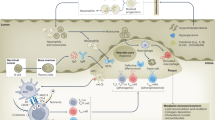Abstract
The binding of radiolabelled lipoproteins, iodine-123-labelled low-density. lipoprotein (LDL) and indium-111-labelled LDL, to peripheral blood mononuclear cells (MNCs) was compared in normolipaemic subjects and in patients with heterozygous familial hypercholesterolaemia (FH). 123I-LDL and 111In-LDL binding to MNCs exhibited high-affinity, highly specific, time- and temperature-dependent binding reaching saturation at concentrations above 50 nM. The number of LDL binding sites (Bmax) was significantly (P<0.01) lower in FH patients (P<0.001; 123I-LDL: Bmax 279±44 ng protein/108MNCs; 111In-LDL: Bmax 309±43 ng protein/108MNCs) as compared with controls (123I-LDL: Bmax 2874±246 ng protein/108 MNCs; 111In-LDL: Bmax 3145±339 ng protein/108 MNCs). The corresponding dissociation constants (K d) were 16±8 nM for 123I-LDL and 12±6 nM for 123In-LDL in healthy volunteers (123In-LDL vs 111In-LDL, P<0.05). In FH patients, the K d values were 20±8 nM for 123I-LDL and 16±6 nM for 123In-LDL (P<0.05 vs controls for both 123I-LDL and 111In-LDL). 111In-LDL binding to MNCs was inhibited (IC50) by 30±8 nM in healthy controls and 38±12 nM in FH patients (P<0.05). 123In-LDL binding to MNCs was inhibited (IC50) by 34±8 nM in healthy controls and 46±10 nM in FH patients (P<0.05). Taken together, these results suggest a reduced number of LDL receptors expressed on MNCs from FH patients. We conclude that 111In-LDL and 123I-LDL are equally well suited as a probe of receptor-mediated binding and uptake of LDL.
Similar content being viewed by others
References
Brown MS, Goldstein JL. A receptor-mediated pathway for cholesterol homeostasis. Science 1986;232: 34–47.
Brown MS, Goldstein JL. How LDL receptors influence cholesterol and atherosclerosis. Sci Am 1984;251: 52–60.
Canner PL, Berge KG, Wenger NK. Fifteen year mortality in Coronary Drug Project patients: long-term benefit with niacin. J Am Coll Cardiol 1996;8: 1245–1249.
Frick M, Elo O, Happa K, et al. Helsinki Heart Study: primary prevention trial with gemfibrozil in middle-aged men with dyslipidemia. Safety of treatment, changes in risk factors and incidence of coronary heart disease. N Engl J Med 1987;317: 1237–1245.
Virgolini I, Angelberger P, Li SR, et al. Indium-111-labeled low-density lipoprotein binds with higher affinity to the human liver as compared to iodine-123-low-density-labeled lipoprotein. J Nucl Med 1991;32: 2132–2138.
Virgolini I, Li SR, Yang Q, et al. Binding of 111In-labeled low density lipoprotein (LDL) to platelets of normolipemic volunteers and patients with heterozygous familial hypercholesterolemia. Arteriosclerosis 1993;13: 536–547.
Havel RJ, Eder HA, Bragdon JH. The distribution and chemical composition of ultracentrifugally separated lipoproteins in human serum. J Clin Invest 1955;34: 1345–1353.
Lowry OH, Rosenbrough OH, Farr AL, Randall RL. Protein measurement with the Folin phenol reagent. J Biol Chem 1951;193: 265–275.
Boyum A. Isolation of mononuclear cells and granulocytes from human blood. Scand J Clin Invest 1968;21: 77–89.
Virgolini I, Angelberger P, Lupattelli G, et al. Comparison of different methods for LDL isolation and radioiodination on liver LDL receptor binding in vitro. Nucl Med Biol 1991;18: 513–517.
Scatchard G. The attraction of proteins for small molecules and ions. Ann NYAcad Sci 1949;51: 660–672.
Brown MS, Goldstein JL. Familial hypercholesterolemia: defective binding of lipoproteins to cultured fibroblasts associated with impaired regulation of 3-hydroxy-3-methylglutaryl coenzyme a reductase activity. Proc Natl Acad Sci USA 1974;71: 788–792.
Ho YK, Brown MS, Bilheimer DW, Goldstein JL. Regulation of low density lipoprotein receptor activity in freshly isolated human lymphocytes. J Clin Invest 1976;58: 1465–1474.
Lupattelli G, Virgolini I, Li S, et al. Low density lipoprotein receptors: preliminary results on “in vivo” study. Wien Min Wochenschr 1991;103: 462–465.
Koller E, Koller F, Binder BR. Purification and identification of the lipoprotein-binding proteins from human blood platelets. J Biol Chem 1989;264: 12412–12418.
Author information
Authors and Affiliations
Rights and permissions
About this article
Cite this article
Banyai, M., Lupattelli, G., Li, S.R. et al. Comparison of iodine-123 low-density lipoprotein (LDL) and indium-111 LDL binding to mononuclear cells of healthy normolipaemic controls and patients with heterozygous familial hypercholesterolaemia. Eur J Nucl Med 21, 634–639 (1994). https://doi.org/10.1007/BF00285585
Received:
Revised:
Issue Date:
DOI: https://doi.org/10.1007/BF00285585




